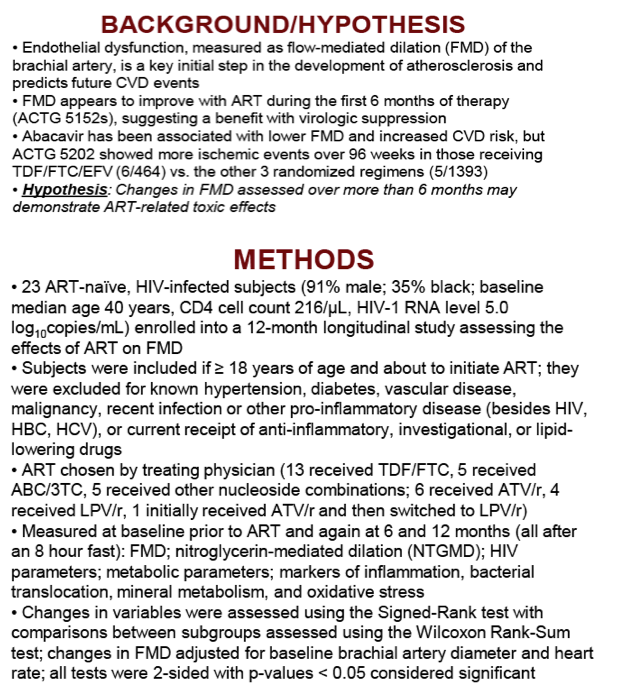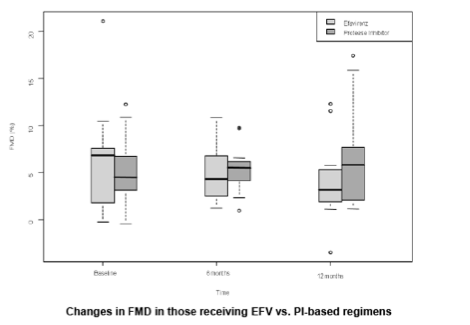 |
 |
 |
| |
Worsening Endothelial Function with Efavirenz
Compared to Protease Inhibitors: A 12-Month Prospective Study
|
| |
| |
Reported by Jules Levin
IDSA Oct 17-21 2012 San Diego
Samir K. Gupta1, Changyu Shen1, Sharon M. Moe1, Lisa M. Kamendulis2, Mitchell Goldman1, Michael P. Dube3
1Indiana University School of Medicine, 2Indiana University, 3University of Southern California Keck School of Medicine
CONCLUSIONS
· EFV-containing regimens may lead to more impaired endothelial function over 12 months compared to those containing protease inhibitors
· TDF/FTC/EFV use was associated with even more pronounced changes in FMD at both 6 and 12 months compared to other regimens
- Both TDF and EFV have been linked to increased intracellular oxidative stress in vitro, and EFV has been linked to worsening endothelial permeability in vitro
· These results may explain the increased number of ischemic events noted in ACTG 5202 with TDF/FTC/EFV
· The changes in FMD were not associated with changes in circulating markers of inflammation, metabolics, bacterial translocation, mineral homeostasis, or oxidative stress
· Limitations include small sample size, lack of randomization, and multiple testing without statistical correction
· Antiretrovirals may lead to endothelial dysfunction and increased CVD risk
ABSTRACT
Background: Changes in endothelial function, measured as flow-mediated dilation (FMD) of the brachial artery, has not been systematically assessed beyond 6 months of initiation of antiretroviral therapy (ART) when drug-related effects might offset initial improvements with virologic control.
Methods: We assessed 6 and 12 month changes in FMD [presented as median (quartile 1, quartile 3)] and circulating HIV and cardiovascular biomarkers in 23 subjects initiating ART in a prospective observational study. ART regimens were chosen by the subjects' primary HIV caregivers.
Results: There were no significant changes in FMD at 6 or 12 months overall despite significant increases in CD4 cell count and HDL-C and reductions in HIV RNA level, MCP-1, IP-10, sVCAM-1, sTNFR2, and sCD14. However, there were significant differences (P=0.04) in the changes in FMD between those receiving efavirenz [N=12; -3.50% (-4.90%, 0.68%)] vs. protease inhibitors at 12 months [N=11; 1.50% (-0.86%, 4.56%)]. The differences in changes in FMD between those receiving and not receiving emtricitabine/tenofovir/efavirenz were more pronounced and were significantly different at both 6 and 12 months (P<0.02 for both). Additional studies showed no significant differences in changes in 25-(OH)-vitamin D, PTH, FGF-23, of F2-isoprostane levels between efavirenz and PI use or between those receiving and not receiving emtricitabine/tenofovir/efavirenz.
Conclusion: Efavirenz use was associated with reduced FMD at 12 months compared to PI-based regimens. Emtricitabine/tenofovir/efavirenz was associated with reduced FMD at both 6 and 12 months compared to those not receiving this specific combination. These results may explain the surprisingly higher number of acute ischemic events found in the emtricitabine/tenofovir/efavirenz arm compared to the other once-daily ART regimens in the randomized trial ACTG A5202. Long-term effects of antiretrovirals on endothelial function may play an important role in the risk of cardiovascular disease in HIV-infected patients.


· FMD did not significantly change overall or in either the EFV or PI subgroups at 6 or 12 months
· Changes in FMD were significantly different between EFV and PI at 12 months {[-3.50% (-4.90%, 0.68%)] vs. [1.50% (-0.86%, 4.56%)]; P=0.04}
· Changes in FMD were significantly different between TDF/FTC/EFV (n=8) vs. other regimens (n=15) at 6 months {[-2.86% (-5.81%, 0.08%)] vs. [1.85% (-0.37%, 4.07%)]; P=0.02} and at 12 months {[-2.19% (-5.13%, 0.75%)] vs. [2.27% (0.003%, 4.54%); P=0.02}
· The inflammatory markers MCP-1, IP-10, sVCAM-1, and sTNFR2 (but not hsCRP or IL-6) and the bacterial translocation marker sCD14 all significantly declined in the entire group over 12 months
· HDL-C significantly increased in the entire group over 12 months; there were no significant changes in TG, TC, LDL-C, or HOMA-IR
· 25-OH-vitamin D, PTH, FGF-23, and F2-isoprostane levels did not significantly change in the entire group, in the EFV or PI subgroups, or in the TDF/FTC/EFV or other regimen subgroups; there were also no significant differences in the changes in these markers amongst these subgroups; however, PTH significantly increased in those receiving TDF vs. those not receiving TDF (P<0.0001)
FMD declined in EFV group from baseline to 6 months & further at 12 months, while FMD appears to increase in PI group.

|
| |
|
 |
 |
|
|